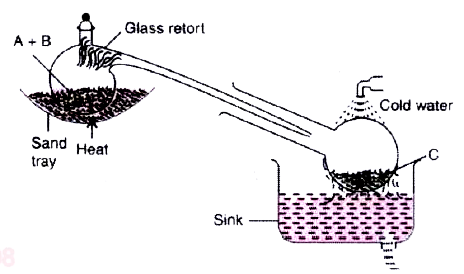What is the property of nitric acid which allows it to react with copper?
To answer the question about the property of nitric acid that allows it to react with copper, we can break down the explanation into clear steps:
1. Identify Nitric Acid:
- Nitric acid is represented by the chemical formula HNO3. It can exist in both concentrated and dilute forms.
2. Understand the Nature of Nitric Acid:
- Concentrated nitric acid is very acidic, while dilute nitric acid contains a significant amount of water, making it less acidic.
3. Recognize the Oxidizing Property:
- One of the key properties of nitric acid is that it is a strong oxidizing agent. This means it has the ability to accept electrons from other substances.
4. Explain the Reaction with Copper:
- When nitric acid reacts with copper, it undergoes a redox reaction. In this reaction, copper (Cu) is oxidized, and nitric acid (HNO3) is reduced.
- The balanced chemical equation for the reaction is:
3Cu+8HNO3→3Cu(NO3)2+2NO+4H2O
- Here, copper goes from an oxidation state of 0 to +2, indicating oxidation, while the nitrogen in nitric acid goes from +5 in HNO3 to +2 in NO, indicating reduction.
5. Conclusion:
- The property of nitric acid being a strong oxidizing agent is what allows it to react with copper. This ability to accept electrons facilitates the oxidation of copper.
- Nitric acid is represented by the chemical formula HNO3. It can exist in both concentrated and dilute forms.
- Concentrated nitric acid is very acidic, while dilute nitric acid contains a significant amount of water, making it less acidic.
- One of the key properties of nitric acid is that it is a strong oxidizing agent. This means it has the ability to accept electrons from other substances.
- When nitric acid reacts with copper, it undergoes a redox reaction. In this reaction, copper (Cu) is oxidized, and nitric acid (HNO3) is reduced.
- The balanced chemical equation for the reaction is:
3Cu+8HNO3→3Cu(NO3)2+2NO+4H2O
- Here, copper goes from an oxidation state of 0 to +2, indicating oxidation, while the nitrogen in nitric acid goes from +5 in HNO3 to +2 in NO, indicating reduction.
- The property of nitric acid being a strong oxidizing agent is what allows it to react with copper. This ability to accept electrons facilitates the oxidation of copper.
Topper's Solved these Questions
- STUDY OF COMPOUNDS OF NITROGEN - NITRIC ACIDBook:ICSEChapter:STUDY OF COMPOUNDS OF NITROGEN - NITRIC ACIDExercise:ADDITIONAL QUESTIONS FOR PRACTICE
Explore 20 Videos
- STUDY OF COMPOUNDS OF CHLORINE - HYDROGEN CHLORIDE Book:ICSEChapter:STUDY OF COMPOUNDS OF CHLORINE - HYDROGEN CHLORIDE Exercise:QUESTIONS FROM PREVIOUS ICSE BOARD PAPERS
Explore 74 Videos
- STUDY OF COMPOUNDS OF NITROGEN- AMMONIA Book:ICSEChapter:STUDY OF COMPOUNDS OF NITROGEN- AMMONIA Exercise:Questions from Preivous ICSE Board Papers
Explore 77 Videos
Similar Questions
What is the property of concentrated sulphuric acid which allows it to be used in the preparation of hydrogen chloride and nitric acid ?
View SolutionThe anhydride of nitric acid is:
View SolutionThe figure given below illustrates the apparatus used in the laboratory preparation of nitric acid.
Write the equation for the reaction in which copper is oxidised by concentrated nitric acid.

View SolutionThe figure given alongside illustrates the apparatus used in the laboratory preparation B of nitric acid.

Write the equation for the reaction in which copper is oxidized by concentrated nitric acid.
View SolutionMolecular weight of nitric acid.
View SolutionFill in the blank from the choices given within brackets:
Cold, dilute nitric acid reacts with copper to form .................. (Hydrogen, nitrogen dioxide, nitric oxide)
View SolutionWrite the equations for the reaction of dilute nitric acid with copper.
View SolutionDrops of nitric acid reacts with P4O10 to gives:
View SolutionWhy should the temperature of the reaction mixture of nitric acid not be allowed to rise above 200∘C?
View SolutionWhat happens when ozone and hydrogen peroxide are allowed to react with each other?
View Solution